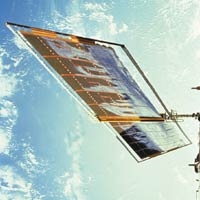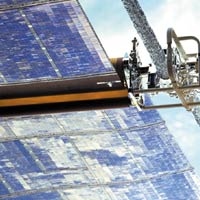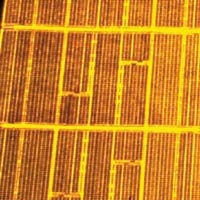Engineering
Solar Panels
Current Solar Array
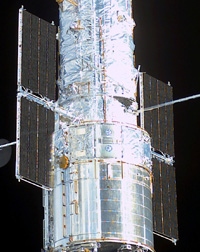 |
With an area 1/3 less than the previous ESA-built set of solar panels, Hubble's third set of solar arrays produces 20% more power. This enables all the science instruments to be turned on at the same time thereby making the observatory even more efficient than in the past. The new panels are more rigid than the previous two pairs and this makes it possible to perform even more stable and pin-point sharp observations. | |
The third set of solar panels seen just after the release of Hubble at the end of Servicing Mission 3B. |
Previous Solar Array
|
|
Hubble's second set of Solar Panels flew with Hubble until 2002 and consists of two large rectangular wings of solar cell blankets. These panels (also called Solar Arrays) rotate so that each wing faces the Sun. The solar cells absorb energy from the sunlight and convert it into electrical energy. The solar cell blankets are mounted in a frame and unfurl from a cassette in the middle of the wing. The tension is maintained by a spreader bar at the end of each side of the wing.
During the First Servicing Mission a new set of Solar Panels was mounted on Hubble to replace the first set which had been oversensitive to temperature variations during Hubble's orbit. The second set had a more advanced system of springs to reduce vibrations induced by temperature differences when Hubble was moving from the bright side of the orbit to the dark side and vice versa. After the installation of the new Solar Panels the vibrations were reduced dramatically. Each Solar Panel wing has 10 individual panels consisting of 2438 solar cells. The panels are less than 0.5 mm thick. The Solar Panels were exchanged during Servicing Mission 3B for more rigid arrays (of the same type which are used on the Iridium Satellites). | |
|
|
||
|
|
Gyroscopes
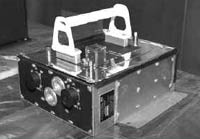 |
|
A Rate Sensor Unit which contains two gyros. |
Inside a gyro a wheel is spinning more than 19 000 times per minute and there are electronics to detect the very small deflections of the wheel's axis.
The gyros are the most accurate in the world and can keep Hubble pointing at the same target for long periods at a time.
Unfortunately some of Hubble's gyros have been hit by problems. Normally this is not a cause for concern (there are three spare gyros), but if four out of six gyros fail, Hubble can no longer observe. This happened a few weeks before Servicing Mission 3A (during which all six gyros were replaced). The source of the gyro problems is thought to be corrosion of some very thin wires inside the gyros.
Electrical Systems
Hubble's Solar Panels are its primary source of power. Each array of solar cells converts solar energy into electrical energy. The electricity produced by the solar cells is used to charge Hubble's batteries.
Hubble has six batteries each consisting of 22 cells in series (and including other components such as additional heaters and electronics). The batteries are packaged in two groups of three in modules weighing about 214 kg each. Each battery holds more than 75 Ampere-hours of energy. This is sufficient to keep the telescope in normal operation for 7.5 hours.

